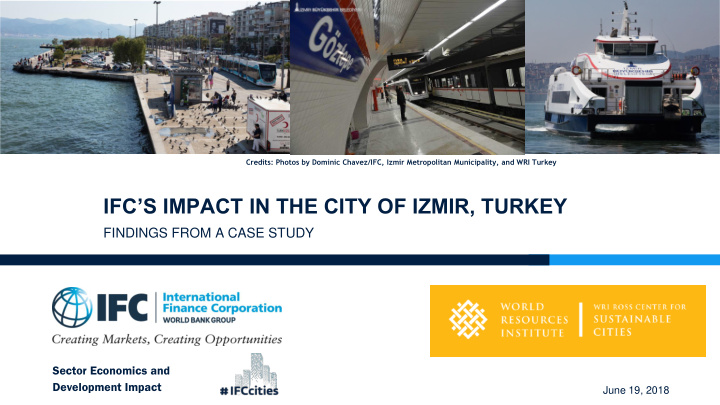



Credits: Photos by Dominic Chavez/IFC, Izmir Metropolitan Municipality, and WRI Turkey IFC’S IMPACT IN THE CITY OF IZMIR, TURKEY FINDINGS FROM A CASE STUDY Sector Economics and Development Impact June 19, 2018
IZMIR CONTEXT – RAPID URBANIZATION Izmir
MOTIVATION - CASE STUDY IFC’s partnership with Izmir spans over a decade 2010 2012 2013 2014 2015 2016 IZSU Dormi- Port Ferry IZSU IZSU Yamanlar ESHOT TMS waste- Tramway WtE tory Railcars expansion boats sewerage Yeni Foca Waste E-Buses water rooms $20 M. $ 65 M. $ 50 M. $ 32 M. $ 62 M. $ 62 M. $10 M. $ 13 M. $ 14 M. Advisory Advisory Advisory IFC role evolved from financing single transactions to become a trusted advisor. Potential to inform future initiatives -> looking forward assessment : 1. Estimation of effects at the city level (not individual transactions) 2. Analysis of benefits from strategic engagement with the city
KEY TAKEAWAYS 1. Investments leading to expanded transport network ops and integration -> better urban mobility . 2. Significant contribution to increase accessibility to employment at the city level, a precondition to enable agglomeration benefits. 3. Limitations: assessment of agglomeration effects constrained by data granularity. 4. Positive implications: city planning and monitoring of global commitments (notably SDG- 11) 5. IFC enabled Izsu (water utility) to test innovative solutions to reduce carbon footprint from waste water treatment plant operations -> demo operationalization of circular economy concepts 6. IFC engagement with both sub sovereign entities (IMM and Izsu) in line with MFD -> catalyzing commercial financing
DIRECT IMPACTS – IMPROVED URBAN MOBILITY IFC investments -> expanded transport operations and obtained synergies between transport modes -> improved urban mobility due to network effects Izmir transport system Benefits for Izmir citizens:
CITY WIDE IMPACTS – METHODOLOGY Baseline IFC projects IFC + Other City Scenario 1 Scenario 2 Investments - 3 Metro Line Metro line + new Baseline + IFC (Existing route) extension (8 new stations) Izban (80km Same as baseline Izban + new Existing route extensions to from Aliaga to Bergama and to Selçuk + new Cumaovasi) direct services added from Aliaga to Tepekoy Ferries (18 Baseline + added Baseline +IFC routes) fleet Tramways Same as IFC (Konak and Karsiyaka) Bus network (48 Same as baseline Same as baseline routes)**
ACCESSIBILITY - CITY WIDE Baseline IFC IFC + other investments
ACCESSIBILITY CITY WIDE IFC + other investments
ACCESSIBILITY - CITY WIDE Bertaud indicator - Average job Accessibility Measure Scenario 1 Scenario 3 IFC projects contributed to increase Number of jobs accessible to all by 4% the number of jobs accessible 79,239 84,555 residents within 60 mins • 5.7% increase -> service sector % of total jobs in the City that 10% 12% are accessible within 60 mins Izmir Los Greater New York Greater Positive results when Indicator (Scenario Angeles Buenos Metro Cairo compared with highly 3) Metro Aires dense Cities with better % Total jobs accessible infrastructure 12% 14% 6% 34% 15% within 60 mins
IMPACTS FROM THE ENGAGEMENT WITH IZSU
ADDITIONALITY F our categories of additionality identified through • Main benefit: Validation to the Market that Izmir Municipality is a IFC Engagement credible borrower without seeking 1. Financial risk mitigation – access to long recourse to sovereign guarantees. term commercial financing on attractive terms when others not willing to provide financing • More collaboration between IFC and 2. Non-financial risk mitigation – risk comfort, Izmir is necessary before market facilitator role with new partners equity finance interest is generated . 3. Knowledge and Innovation – shared knowledge, improved fin risk management • On Izmir's side, willingness to 4. Standard setting: better processes --> strengthened provide open access to urban transparency and accountability services performance data is necessary for attracting private Piloting of MfD -> IMM access to commercial financing investor interest and testing of circular economy concepts by IZSU
KEY TAKEAWAYS Key findings 1. Evidence of significant IFC contributions to city wide impacts: a. 4% increase in number of accessible jobs, notably services. b. A citizen in Izmir will reach 12% of available jobs, similar to other mega cities. 2. Limitations: agglomeration effects constrained by data granularity/access. 3. IFC enabled IZSU (water utility) to test innovative solutions to reduce carbon footprint -> demo circular economy concepts Lessons learned on methodology 1. Tool -> simple and leverages digital, open, and standardized data (Open street map, GTFS) – challenges to get data when ownership is not well defined. 2. Method -> Bertraud indicators useful to measure city wide effects.
Contact information: IFC Sector Economics and Development Impact: Enrique Lora • IFC Cities ECA: Patrick Avato, Ozan Beser, Elif Ismen, Denis • Obarcanin, and Marco Sorge WRI Ross Center for Sustainable Cities: Vijay Jagannathan, • Robin King Credits: Photos by Dominic Chavez/IFC, Izmir Metropolitan Municipality, and WRI
ANNEX 1 – THEORY OF CHANGE
ACCESSIBILITY ANALYSIS FOR IZMIR Changes in job accessibility within an area near the Konak tram and Metro extension, within 75 minutes The table and map display dramatic improvements in job accessibility within an area near the Konak tram and Metro extension between Scenarios 1 and 3 within a 75 minute travel time window
ACCESSIBILITY BY EMPLOYMENT SECTORS Population-weighted Average Accessibility to Jobs within 75 mins Agriculture/ Natural Manufacturing Services Resources Scenario 1 769 24,507 88,419 Scenario 3 801 25,708 92,990 % Increase between the two scenarios 4.16% 4.90% 5.17% 100 90 80 70 % of Population 60 50 40 30 20 10 0 0 10 20 30 40 % of Total Jobs (within each Sector)
Recommend
More recommend